Is The Star Trek Animated Series Canon
Real Earth commodity
(written from a Production point of view)
Star Expedition: The Animated Series , originally and formally titled Star Expedition and The Animated Adventures of Gene Roddenberry's Star Trek , was a continuation of the voyages of the USS Enterprise, previously featured in Star Expedition: The Original Series.
- Master Title Theme file info (composed by "Yvette Blais" (Ray Ellis) and "Jeff Michael" (Norman "Norm" Prescott, main partner of Lou Scheimer in the animation studio Filmation Associates)
Summary
On the television network NBC, 22 episodes of The Animated Series were aired between September 1973 and October 1974. Reruns continued on NBC through 1975. The serial was produced by the experienced animation house Filmation and the episodes were scripted by professional science fiction and Star Trek writers, including Larry Niven, D.C. Fontana, David Gerrold, and Samuel A. Peeples.
Some of the stories were sequels to episodes from the original series, such every bit "More Tribbles, More Troubles" (the follow-up to "The Trouble with Tribbles"), "Once Upon a Planet" (a sequel to "Shore Get out"), and "Mudd's Passion" (the follow-up to "Mudd'southward Women" and "I, Mudd").
With the exception of Ensign Chekov, all of the regular characters from the original serial connected to appear, voiced by the original actors from that serial (Chekov was absent to cut downwards on costs of hiring the voice actors, although Walter Koenig penned an episode of the serial, "The Infinite Vulcan"). Dr. McCoy was a full commander, and Nurse Chapel was a full lieutenant. New characters, such as Arex and Chiliad'Ress, were also featured. The show was the nigh expensive animated evidence on the air at the time, primarily because vi "name" actors from Star Trek: The Original Series provided the voices for their characters. Nearly all the aliens and invitee characters were voiced by James Doohan, Nichelle Nichols, and Majel Barrett, although some actors reprised their roles from the original serial. Leonard Nimoy (Spock) is the merely thespian to phonation his graphic symbol in every episode of TAS. James Doohan, however, voiced unlike characters in every episode of the serial, but missed only one episode every bit Montgomery Scott, the episode being "The Slaver Weapon".
Among the returning guest actors (and characters) were Marking Lenard (as Sarek), Roger C. Carmel (as Harry Mudd), and Stanley Adams (as Cyrano Jones). Although the characters Amanda Grayson, Bob Wesley, Kyle, Kor, Koloth, and Korax returned in The Animated Series, their voices were provided past the aforementioned voice talents of Majel Barrett and James Doohan.
The show featured a scattering of new technologies like the recreation room (later the idea was reused in TNG, where it was known every bit a holodeck) and the aqua-shuttle. It besides featured many not-humanoid alien species (and even some alien officers aboard the Enterprise) who could not have been featured within the original series' budget.
Roddenberry was adamant that this show was Star Trek (i.e. the continuation of the original series) leading to information technology having the same title. The add-on of The Animated Series to the title was not until years later.
The serial, which lasted 2 years, could be viewed as the completion of the Enterprise'southward v-year mission. D.C. Fontana personally viewed all 22 episodes as year four. StarTrek.com considers the seasons collectively to correspond the fifth and last year of the mission. [1] (X)
Although at one signal Paramount Pictures did non regard the animated series as canonical, with the release of The Blithe Serial DVD, the studio appears to have inverse its stance, and is leaning towards the animated series beingness function of established Star Expedition canon. [2] (X) [3] (X) [iv] (X) References from the series have gradually become more accustomed in other Star Trek series, most notably on Star Expedition: Deep Space Nine, Star Trek: Enterprise and Star Trek: Lower Decks (see the "questionable catechism" department below for the complete list of references). Gene Roddenberry said that if he had known there would exist more live-action Star Trek in the future, the animated series would take been far more than logical and "canonable," or he might not have produced the blithe series at all.
A DVD collection of the complete serial was released on 21 Nov 2006 for Region ane.
Bandage
Starring the voices of
- William Shatner equally Captain Kirk
- Leonard Nimoy as Mr. Spock
- And
- DeForest Kelley as Dr. McCoy
Also starring the voices of
- George Takei as Sulu
- Nichelle Nichols as Uhura
- Majel Barrett as Chapel and M'Ress
- James Doohan as Scott and Arex
Episode list
Flavour 1
TAS Season 1, 16 episodes:
| Title | Episode | Prodno. | Stardate | Original Airdate |
|---|---|---|---|---|
| Beyond the Farthest Star | 1x01 | 22004 | 5221.3 - 5221.8 | 1973-09-08 |
| Yesteryear | 1x02 | 22003 | 5373.4 | 1973-09-fifteen |
| 1 of Our Planets Is Missing | 1x03 | 22007 | 5371.3 - 5372.1 | 1973-09-22 |
| The Lorelei Point | 1x04 | 22006 | 5483.vii - 5483.nine | 1973-09-29 |
| More Tribbles, More Troubles | 1x05 | 22001 | 5392.4 | 1973-10-06 |
| The Survivor | 1x06 | 22005 | 5143.3 | 1973-10-13 |
| The Space Vulcan | 1x07 | 22002 | 5554.four -5554.8 | 1973-x-twenty |
| The Magicks of Megas-Tu | 1x08 | 22009 | 1254.4 | 1973-10-27 |
| Once Upon a Planet | 1x09 | 22017 | 5591.2 | 1973-eleven-03 |
| Mudd'south Passion | 1x10 | 22008 | 4978.5 | 1973-11-10 |
| The Terratin Incident | 1x11 | 22015 | 5577.3 - 5577.7 | 1973-11-17 |
| The Time Trap | 1x12 | 22010 | 5267.2 - 5267.6 | 1973-11-24 |
| The Ambergris Element | 1x13 | 22013 | 5499.9 | 1973-12-01 |
| The Slaver Weapon | 1x14 | 22011 | 4187.3 | 1973-12-fifteen |
| The Eye of the Beholder | 1x15 | 22016 | 5501.2 | 1974-01-05 |
| The Jihad | 1x16 | 22014 | 5683.1 | 1974-01-12 |
Season two
TAS Season 2, 6 episodes:
| Title | Episode | Prodno. | Stardate | Original Airdate |
|---|---|---|---|---|
| The Pirates of Orion | 2x01 | 22020 | 6334.1 - 6335.6 | 1974-09-07 |
| Bem | 2x02 | 22018 | 7403.vi | 1974-09-fourteen |
| The Practical Joker | 2x03 | 22021 | 3183.3 | 1974-09-21 |
| Albatross | 2x04 | 22019 | 5275.vi - 5276.8 | 1974-09-28 |
| How Sharper Than a Ophidian'south Tooth | 2x05 | 22022 | 6063.iv - 6063.5 | 1974-10-05 |
| The Counter-Clock Incident | 2x06 | 22023 | 6770.1 - 6770.6 | 1974-10-12 |
Groundwork data
Origins
Former Original Series writer D.C. Fontana reported in the fanzine Star-Borne of 22 June 1972 that, "Paramount... [is] enormously impressed by the quantity (and quality) of fan post they continue to receive. The possibility seems to be slowly developing of a Star Expedition characteristic movie for theatrical release, aimed at becoming the new Star Trek television pilot… on the network forepart, NBC nevertheless expresses not bad interest in doing Star Trek in some form. Both NBC and Paramount go on to receive a bully deal of postal service and have had to assign secretaries for the sole job of answering it." [5]
NBC's surprising consummate turnaround (as it were they who had canceled the live-action precursor in 1969, purportedly for poor ratings performance) not only stemmed from the spectacular resurgence of the Original Series in syndication, but too from its own accounting section. Shortly before Fontana'south report, NBC had replaced its old Nielsen rating system with a new and updated one. Mystified past the success of a prove in syndication they were convinced was a flop, they decided to run the original Original Series figures through their new arrangement they and institute out much to their surprise that information technology had not only reached total penetration into their most coveted target audience, the male person population between 18 and 45, merely also that the series had been one of the well-nigh successful series the network had always aired. The sickening realization hit upon the dismayed network executives that they had slaughtered the proverbial goose that laid the golden eggs, something that every Star Trek fan at the time could take told them. Hurriedly approaching Roddenberry to run into if the serial could be revitalized, it turned out to be unfeasible, as Paramount had but a few months before cleared out their warehouses from the vast majority of the remaining Star Trek production avails, they either being scrapped, given away or but stolen. Recreating them, calculated at US$750,000, was accounted far too toll-prohibitive. It did however lead NBC to commission the creation of The Animated Series. (Star Trek - Where No One Has Gone Earlier, pp. 51-52)
Fifty-fifty though they did not produce the new series themselves, Paramount Pictures, possessing all rights and title to the Star Expedition brand, was legally the owner of the new property.
The first recordings
The outset recording session for the animated Star Trek serial was in June 1973 (on or prior to the quaternary of that calendar month). (The Star Trek Compendium, 4th ed., p. 143; Star Expedition: Communicator issue 119, p. 32) This was with the entirety of the series' regular cast and was the first time they had reunited since production of the original serial concluded in Jan 1969. The recording session was held at Filmation's studios in Reseda, California, where the performers recorded the first three scripts for the serial ("Beyond the Farthest Star", "Yesteryear", and "More Tribbles, More Troubles"). (Star Expedition: Communicator effect 119, p. 32)
Lou Scheimer reminisces about the bandage, "The glorious thing was getting them all together for the first recording session […] It was a joyous occasion." ("Drawn to the Final Frontier – The Making of Star Trek: The Animated Series", TAS DVD) William Shatner recalls how he got into character; "[Kirk had] been locked away inside me for well-nigh four years, but as presently as I opened my mouth to read his first line he was back. Slipping dorsum into that grapheme was like putting on a comfortable old sweatshirt; it fit." (Up Till Now: The Autobiography, p. 171)
On 4 June 1973, NBC publicly announced that the initial recording session had gone ahead. (Star Trek: Communicator event 119, p. 32)
Emmy win
In 1975, the animated series of Star Expedition won a Daytime Emmy Honor in the expanse of "All-time Children's Serial" for the 1974-1975 television season. Although Star Trek'southward original serial had repeatedly been nominated for Emmys, this was the kickoff such award that the franchise actually won. Information technology became besides the only best-series Emmy ever won past Star Trek as of 2020. It beat Captain Kangaroo and The Pink Panther. (Star Trek: The Animated Series-special feature: "Fatigued to the Terminal Frontier – The Making of Star Trek: The Animated Serial"; Star Trek - Where No Ane Has Gone Before, p. 57, et al.) Incidentally, the series had already been nominated for the aforementioned award in its inaugural debut the twelvemonth previously, [half dozen] but lost out on that occasion to PBS'south Zoom.
The series essentially won the award on the basis of a certain episode. "When Filmation submitted Star Trek for the Best Children'due south Serial Emmy, ['How Sharper Than a Snake's Tooth'] is the episode they submitted," explains David Wise, a co-writer of that installment. ("How Sharper Than a Snake's Tooth" audio commentary) The episode's other co-writer, Russell Bates, comments, "[The episode] became the only credential submitted when Filmation received an Emmy nomination for the series, and thus was instrumental in the winning of a 1975 Emmy Accolade." Bates as well notes that the Emmy was not the only honour that the episode attained. [seven]
Shortly later Hal Sutherland and his family unit moved out of Los Angeles to Washington state, he received a phone call that informed him of the Emmy nomination. He remembers, "This was exciting news and I spread the give-and-take to all of our friends and neighbors in case Filmation picked up the Emmy." As he learned prior to the event, it was to be presented in New York and Lou Scheimer decided to bring his own family to the festivities. [8] The ceremony was really on a boat in the New York harbor. Lou Scheimer's son, Lane, heard a do session, below-decks, of the announcements being rehearsed. The elder Scheimer reflects, "He said, 'Dad, don't worry, I merely saw them downwards in that location and they said it was Captain Kangaroo' [....] So I was sitting there, drinking wine, not worried, and [getting] one-half-plastered." (Star Trek Mag Souvenir Special, p. 58) Scheimer likewise personally doubted that the animated Star Trek series was about to receive the honor. He states, "I was absolutely certain we weren't going to win; at that place was no mode that evidence could win considering it actually was not a kids' show." (Star Trek: The Magazine Book 1, Consequence 16, p. 68)
Hal Sutherland recalls tuning into the televised coverage of the upshot; "I remember gathering the family unit to watch the laurels ceremonies with me. I hoped to make them proud of what we had accomplished in some way. Sitting in front of the TV, I watched with anxiety as the nominations for all-time animated series came up […] The award envelope was opened and Star Trek was announced the winner for its category." [9] Lou Scheimer (who says he was "a nervous wreck" at the fourth dimension), also recollects the announcement; "Cyril Richard gets up there and says, 'And the best children'southward programming for Sat morning is Star Trek and Lou Shimmer [sic]. I didn't know what to practice. You cannot tell, but I was floating." (Star Trek Magazine Gift Special, p. 58) Hal Sutherland continues, "Lou stepped to the podium to make his credence speech." [10] A transcript of that spoken communication follows:
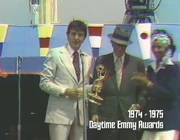
Lou Scheimer accepts the series' just Emmy
- "My son overheard the rehearsals and he heard it was Captain's Kangaroo, so I don't know what to say… except a very, very special thanks to my very, very special friend and co-producer, Norm Prescott, and my lovely family, my wife, Jay… my son and my girl, Lane and Erika, and to all those great, dandy people who produced for usa – in the art of animation, at Filmation – those wonderful shows. Thanks very, very much." ("Fatigued to the Final Frontier – The Making of Star Trek: The Blithe Series", TAS DVD)
Lou Scheimer recalls the shock of having to collect the award; "I was totally flabbergasted when we did [win]. I didn't know what to say; I was not prepared. I was just balked at the idea of being in forepart of all those people, waiting to hear me say something meaningful." (Star Trek: The Magazine Book ane, Issue sixteen, p. 68)
Watching Lou Scheimer's acceptance speech communication was a very emotional experience for Hal Sutherland and he was enormously disgruntled that Scheimer thanked Norm Prescott rather than him. Although Sutherland never expressed his farthermost thwarting to the award recipient, Scheimer finally apologized to Sutherland in 2004. "He […] sorrowfully related to me an apology for his 'drunken' statement at the Emmy affair regarding his defoliation between Norm and I and the production credits," explained Sutherland. "We'd both carried that haunting retentiveness all those many years, neither wanting to bring up the tender subject. We later kissed [and made up, putting the upshot backside them]." [11]
Lou Scheimer criticized the winning of the award, saying that – even though it was "the only Emmy I've e'er gotten for a show" – it was inappropriate for the animated Star Expedition to receive an accolade for a children's show, since the series was actually meant to be "a show for the entire family and everyone who was actually a fan of the original live-action show." ("Drawn to the Final Frontier – The Making of Star Trek: The Animated Series", TAS DVD) Norm Prescott, on the other manus, considered the accolade to be a high point in Filmation's history. (Star Trek: Communicator issue 119, p. 79) Both Filmation, in general, and the writers of "How Sharper Than a Snake'due south Molar", were happy that the episode gained the series the honour. David Wise reminisces, "We, Russell [Bates] and I, considered that an accomplishment. Filmation was thrilled and invited u.s.a. to an Emmy party and all sorts of fun things similar that." ("How Sharper Than a Serpent's Molar" audio commentary) Gene Roddenberry regarded the award win equally "the best proof" that the animated serial had been "a fairly good job." (The Making of Star Trek: The Motion Flick, p. 20) D.C. Fontana was besides "pleased" that the franchise had finally won an Emmy, later stating, "I was thrilled to death." ("Drawn to the Last Frontier – The Making of Star Expedition: The Animated Series", TAS DVD) In their text commentary for serial finale "The Counter-Clock Incident", Michael and Denise Okuda depict the Emmy win as the serial having been "honored." The book Star Trek - Where No One Has Gone Before (p. 57) refers to the win as "a fitting send-off" for the series.
Considering the efforts the writers, including Bates, put in to tell more than mature stories akin to the primary series, the win of a "children's" award turned out to be somewhat of a mixed blessing as information technology cemented the impression of Star Trek being an immature, superficial show for adolescents but at best in the minds of the non-fan guild at large, which started to become wary of the emerging "Trekkie" phenomenon. It became a large part of the reasons why to appointment a substantial function of "Trekdom", Creator Gene Roddenberry included, connected to reject to consider The Animated Serial part of canon, as related futurity. (Star Trek: The Official Guide to the Blithe Serial, pp. 8 & 153) Most ironically, the six-episode second season of Star Trek: Short Treks, which only became nominated in 2020 for Star Trek'south 5th "major" Emmy Award, did include two animated episodes, "Ephraim and Dot" and "The Girl Who Made the Stars", specifically intended for children.
Questionable catechism and reintegration
Co-ordinate to Voyages of Imagination [page number? • edit] , the Animated Serial was officially removed from canon at Gene Roddenberry's request in 1988, with the exception of some parts involving Spock's youth, from Fontana's episode "Yesteryear". This had already been confirmed previously by reference volume author Mike Okuda in the introductions of his works. (Star Trek Chronology (second ed., p. vii); Star Trek Encyclopedia (quaternary ed., vol. one, p. introduction); [12] (10) ) Paramount Pictures has followed suit by elevating the request to policy, having officially declared the series non-catechism. (Star Expedition Encyclopedia (1st ed., p. 3))
Despite this request, Memory Alpha recognizes The Blithe Series as a valid resource. There were also strong indications from the StarTrek.com (former) official website that TAS was unilaterally, yet formally, re-added to the official canon in 2006 by the franchise for the sole purpose of commercially promoting the occasion of the series' release on DVD that year. ([13] (X) [14] (X) [fifteen] (10) ; See also the content policy).
Writers from later Star Expedition series have integrated various references from the series into their works. Star Trek: Enterprise author/producer Manny Coto once remarked, "They did some peachy stuff in the animated serial and why not use some of that?" (Cinefantastique, Vol. 37, No. 2, p. 37) Star Trek: The Side by side Generation and Star Trek: Deep Infinite Nine writing staffer Ronald D. Moore likewise commented, "It's kinda cool to throw in the odd reference [to TAS] here and there." (AOL chat, 1998) The following references were used in subsequent series:
- The episode "Yesteryear" has been considered catechism or "semi-canon" by some of the product staff, and equally such, information from this episode is more prevalent in later series:
- The city of Shi'Kahr resurfaced on an okudagram in "The Emissary" chosen the "Shi-Kar Desert Survival, Vulcan", which was also a reference to Spock'southward kahs-wan. The city was again indirectly mentioned in "Fusion" in reference to the Shi'Kahr Academy, and later served equally the namesake for the USS ShirKahr, seen but non mentioned in "Tears of the Prophets". A Vulcan metropolis which looks very similar to Shi'Kahr was shown in the new establishing shots used in the remastered version of "Amok Time".
- An okudagram featured in "Middle of the Beholder" referenced the Sepek Academic Scholarship, which coincides with the name of a Vulcan child in "Yesteryear".
- Vulcan's Forge was after referenced in "Change of Heart" and was the focus of a three-episode ENT arc: "The Forge", "Awakening", and "Kir'Shara".
- Both Lunaport and the kahs-wan were mentioned in "The Catwalk".
- The sehlat, which beginning appeared in "Yesteryear" in animated course, was recreated in CGI in ENT: "The Forge".
- The nearby planet seen briefly behind Shi'Kahr made it into the original version of Star Trek: The Motion Picture . For the director'due south cut information technology was decided to remove the planet (named Charis or T'Khut in the novel Spock's Globe).
- The title of "healer" for a Vulcan physician was referred to for Healer Senva in "Prophet Motive".
- Star Trek Six: The Undiscovered Country confirmed Kirk'south centre name as "Tiberius", a name outset revealed in "Bem". The proper name had been used in novels, including in the preface to the novelization of Star Trek: The Motion Movie.
- A chart of Federation space, seen in "Conspiracy", contained references to solar objects first mentioned in TAS, including the planets Canopus 3, Lactra Seven, Omega Cygni, Phylos, and Kzin, and the stars Beta Lyrae and Pallas 14.
- In the episode "Once again Unto the Breach", Kor recalled his former vessel, the IKS Klothos, which was the send he allowable in the "The Time Trap". Information technology was a D5 Klingon ship (where D5s were later shown in Enterprise), rendered as a questionably-fatigued D7, but in both cases it was allowable by Kor.
- The episode "Broken Link" referred to Edosian orchids, the episode "These Are the Voyages..." mentioned Edosian suckerfish, and in that location were several other Enterprise references to the Edosian slug – all homages to the Edosian Lt. Arex.
- Coincidental references which may or may not be attributed to terms starting time used in The Blithe Series include Klingon Imperial Fleet ("The Time Trap") and Starbase 23 ("The Terratin Incident").
- Amanda'south maiden name, Grayson, was given in the series, and after established in Star Trek V: The Final Frontier .
- The holodeck concept start appeared in "The Practical Joker", and was afterward adopted into Star Trek: The Adjacent Generation. The utilise of holograms was used in "Lethe", showing that USS Discovery was equipped with similar applied science during 2250s.
- The idea of an boosted turbolift on the bridge first appeared in TAS, and ultimately adopted in the live-activeness franchise from Star Trek: Phase Two onward.
- The act of entering the warp nacelles first appeared in TAS, and afterward appeared in the TNG episode "Eye of the Beholder" and in the ENT episode "The Catwalk".
- In "The Counter-Clock Incident", a race is shown that has a lifespan where individuals start out former and grow younger until expiry. Star Trek: Voyager later reused this idea in one of its episodes for a race of aliens.
- In Star Expedition IV: The Voyage Home , two members of the Caitian species are seen, which FASA's RPG sourcebook, Star Trek Iv Sourcebook Update, identified equally the same species as M'Ress.
- The robot grain ships from "More Tribbles, More Troubles" have later been established in the 2008 remastered TOS episodes "Charlie 10" (manned version) and "The Ultimate Figurer" (robot version) as belonging to the Antares-type of starships. Later to also announced as wreckage in the Lower Decks episode "Last Provocations".
- Star Expedition: Discovery confirmed Robert Apr from "The Counter-Clock Incident" to exist an important Starfleet helm in the episode "Choose Your Hurting" when Saru asks the ship's computer to list Starfleet's most decorated captains. He was later confirmed equally the beginning captain of the USS Enterprise, preceding Christopher Pike, in "Brother".
- Lower Decks also made a mention of Spock Ii from "The Infinite Vulcan" in "Veritas" before featuring his skeleton in "Kayshon, His Optics Open up".
- Several Lower Decks episodes take depicted members of alien species that originally debuted in The Animated Series, including:
- "Second Contact" introduced another Caitian, T'Ana, equally a series' regular.
- "Envoys" included the Aurelian from "Yesteryear"and the Vendorian from "The Survivor".
- "Much Ado Near Boimler" introduced an Edosian character whose species was first featured through the series' regular Arex.
- "Mugato, Gumato" included the appearance of a Kzinti from "The Slaver Weapon".
- "An Embarrassment Of Dooplers" depicted a total of v TAS species appearances, the aforementioned Caitian, Kzinti, Edosian, Aurelians, and a prominent return of several members of Em/3/Greenish'due south species, who get-go appeared in "The Jihad".
Several not-catechism productions take also made reference to TAS:
- A 2nd leave for the bridge, referenced in Franz Joseph's Star Fleet Technical Transmission.
- DC Comics' writer Len Wein reintroduced One thousand'Ress and Arex into the post- Star Expedition IV: The Voyage Home comics, and they were farther developed by Michael Carlin and Peter David until that series went into hiatus.
- Some of the worlds and aliens in the series were included in the 1989 volume called The Worlds of the Federation.
- Author Peter David later integrated M'Ress and Arex into his 24th century volume serial Star Trek: New Frontier, beginning with the novel Gateways #6: Cold Wars. They also appear in IDW'south "New Frontier" comic miniseries, Turnaround, by David.
- The trilogy Crucible by David R. George 3 includes the plot from "Yesteryear" in its history.
- The IDW comic miniseries Star Trek: Year Four takes identify during the TAS timeframe and features appearances past Arex and M'Ress.
Production inconsistencies
I unfortunate reality of an animated television series was the occasional color discrepancy.
The most notable color discrepancy was shown with several appearances of the color pink. Unknown to the residual of the product staff, director Sutherland was color-blind, then to him, pink was light grey. ("Drawn to the Concluding Frontier – The Making of Star Trek: The Animated Series", TAS DVD) While true, Kaplan was not colour-blind and was ofttimes conscientious of the color decisions beingness made.
The following images are examples of Irv Kaplan's personal colour choices:
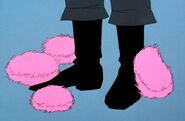
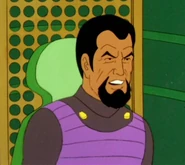
Pinkish Klingon uniforms
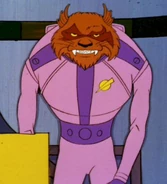
Pink Kzinti uniforms
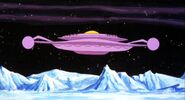

Red dragons
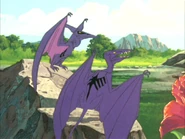
Purple Pterodactyls
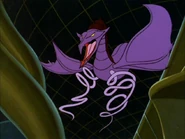
Purple swooper
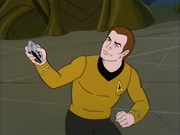
Reversed color variant
According to Bob Kline, "Pink equals Irv Kaplan. Irv was in charge of ink and pigment, coloring the various characters and props (and he would exercise it himself in his office, he would sit downwards with a cel and pigment it). He was also referred to by many people at that place equally the purple and greenish guy. You'll meet in a lot of scenes, regal and greenish used together – that was one of his preferences. He made dragons red, the Kzintis' costumes pinkish. Information technology was all Irv Kaplan'due south call. He wasn't listening to anyone else when he picked colors, or anything." (Star Trek: The Official Guide to the Animated Serial, p. 26)
Several other unintentional coloring problems likewise cropped up. Kirk's type 1 phaser had its colour scheme reversed (black on silvery/grey, instead of silvery on blackness), and some shots featured characters wearing Starfleet uniforms of the wrong division or colors.
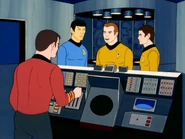
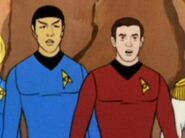
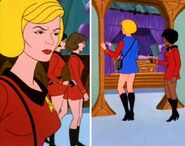
Chapel wears an operations partition uniform (and sciences division compatible with crimson sleeve)

A helmsman wearing an operations partitioning uniform with a command division assignment patch

An engineer wearing a sciences segmentation uniform with an operations division consignment patch
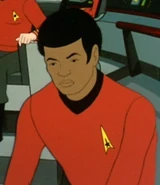
A second helmsman also wearing an operations division compatible with a command division assignment patch
As a consequence of the employ of recycled footage, there were too many instances of randomly misplaced characters and equipment. Recurring inconsistencies in this vein include the random appearance of Lt. Kyle in several transporter room scenes, close-up shots of Scott operating the transporter controls, the interchanged appearances with Uhura and Thou'Ress at the communications station, and the advent of characters on the span while simultaneously appearing in another section of the ship or on the surface of a planet.
Another inconsistency that appears sometimes is Scott shown with the rank of helm, and Kirk with a unknown rank insignia.
The Animated Series also made substantial changes to ready locations used in the original series:
- A second turbolift is installed on the bridge, adjacent to the main viewscreen.
- The span stations are rounded, and class a perfect circle, instead of the hexagonal TOS bridge set.
- The access stairs to the upper level engineering science deck (seen in TOS seasons 2 and three) are gone.
One production glitch that was avoided from existence televised was Uhura having white skin. "Someone in the paint department used Nurse Chapel's colors on Uhura, who turned Caucasian with the flip of a brush!" exclaims Malcolm C. Klein, a management and marketing consultant to Filmation. "Fortunately, that one was caught before the moving-picture show reached the lab." (Starlog, Vol. two, No. vi, p. 47)
On many other occasions, trunk parts on various characters would get missing. According to animator Bob Kline, "information technology was commonly something the cameraman did on purpose or accident to go on the cel levels at six. You lot couldn't use more than six cel levels under the camera." This was ofttimes completed to allow more animation to appear on screen, as anymore than vi cells would brand the animation appear "muddier". (Star Trek: The Official Guide to the Animated Series, p. 27)
- TAS directors
- TAS performers
- TAS recurring character appearances
- TAS writers
- Composers
- Star Expedition Logs by Alan Dean Foster
- Undeveloped TAS episodes
- Star Trek: Final Frontier, a proposed but undeveloped animated serial
- Star Trek: Lower Decks
- Star Expedition: Prodigy
Media
- These Are the Voyages: Gene Roddenberry and Star Trek in the 1970s, Volume one (1970-75), Feb 2019
- Star Trek: The Official Guide to the Animated Series, September/October 2019
Dwelling house video formats
- Star Trek: The Animated Series on VHS
- Star Trek: The Blithe Serial on Betamax
- Star Trek: The Blithe Serial on LaserDisc
- Star Expedition: The Animated Series on DVD
- Star Trek: The Animated Serial on Blu-ray
| Star Trek television series |
|---|
| The Original Series • The Blithe Series • The Next Generation • Deep Infinite Ix • Voyager • Enterprise • Discovery • Picard • Lower Decks • Prodigy • Strange New Worlds |
| Companion series: After Trek • Brusque Treks • The Ready Room |
| In evolution: Untitled Section 31 series • Untitled Khan series |
External links
- Star Trek: The Animated Series at Retentivity Beta, the wiki for licensed Star Trek works
- Star Expedition: The Blithe Serial at Wikipedia
- Star Trek: The Animated Serial at StarTrek.com, the official Star Expedition website
- The Making of Star Trek: The Animated Series (Ten)
- The Animated Serial Gets Existent (10)
- Guide to Animated Star Trek
- Star Expedition: The Animated Series at Ex Astris Scientia
- Star Trek: The Animated Series at the Internet Motion-picture show Database
- Star Trek: The Animated Series – fan site
Source: https://memory-alpha.fandom.com/wiki/Star_Trek:_The_Animated_Series
Posted by: wasonlikeeped.blogspot.com


0 Response to "Is The Star Trek Animated Series Canon"
Post a Comment